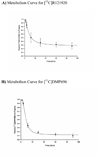PET Imaging of CRF1 with [11C]R121920 and [11C]DMP696: is the target of sufficient density?
- PMID: 17499724
- PMCID: PMC1933490
- DOI: 10.1016/j.nucmedbio.2007.01.012
PET Imaging of CRF1 with [11C]R121920 and [11C]DMP696: is the target of sufficient density?
Abstract
Aim: Overstimulation of the CRF type 1 receptor (CRF1) is implicated in anxiety and depressive disorders. The aim of this study was to investigate the in vivo binding characteristics of [11C]R121920 and [11C]DMP696 in the nonhuman primate for application in positron emission tomography (PET) studies of CRF1.
Methods: PET imaging with the two novel CRF1 radioligands was performed in baboon. In vitro binding studies for CRF1 were performed in postmortem brain tissue of baboon and human to assess sufficiency of receptor density for PET.
Results: Both [11C]R121920 and [11C]DMP696 distributed rapidly and uniformly throughout the brain. Washout was comparable across brain regions, without differences in volume of distribution between regions reported to have high and low in vitro CRF1 binding. Membrane-enriched tissue homogenate assay using [(125)I]Tyr(0)-sauvagine and specific CRF1 antagonists CP154,526 and SN003 in human occipital cortex yielded maximal binding (Bmax) of 63.3 and 147.3 fmol/mg protein, respectively, and in human cerebellar cortex yielded Bmax of 103.6 and 64.6 fmol/mg protein, respectively. Dissociation constants (K(D)) were subnanomolar. In baboon, specific binding was not detectable in the same regions; therefore, Bmax and K(D) were not measurable. Autoradiographic results were consistent except there was also detectable CRF1-specific binding in baboon cerebellum.
Conclusion: Neither [11C]R121920 nor [11C]DMP696 demonstrated quantifiable regional binding in vivo in baboon. In vitro results suggest CRF1 density in baboon may be insufficient for PET. Studies in man may generate more promising results due to the higher CRF1 density compared with baboon in cerebral cortex and cerebellum.
Figures





References
-
- Vale W, Spiess J, Rivier C, Rivier J. Characterization of a 41‐residue ovine hypothalamic peptide that stimulates secretion of corticotropin and beta‐endorphin. Science. 1981;213:1394–1397. - PubMed
-
- De Souza EB. Corticotropin‐releasing factor receptors: physiology, pharmacology, biochemistry and role in central nervous system and immune disorders. Psychoneuroendocrinology. 1995;20:789–819. - PubMed
-
- Behan DP, Grigoriadis DE, Lovenberg T, Chalmers D, Heinrichs S, Liaw C, et al. Neurobiology of corticotropin releasing factor (CRF) receptors and CRF‐binding protein: implications for the treatment of CNS disorders. Mol Psychiatry. 1996;1:265–277. - PubMed
-
- Behan DP, De Souza EB, Lowry PJ, Potter E, Sawchenko P, Vale WW. Corticotropin releasing factor (CRF) binding protein: a novel regulator of CRF and related peptides. Front Neuroendocrinol. 1995;16:362–382. - PubMed
-
- Grigoriadis DE, Lovenberg TW, Chalmers DT, Liaw C, De Souze EB. Characterization of corticotropin‐releasing factor receptor subtypes. Ann N Y Acad Sci. 1996;780:60–80. - PubMed
Publication types
MeSH terms
Substances
Grants and funding
LinkOut - more resources
Full Text Sources

